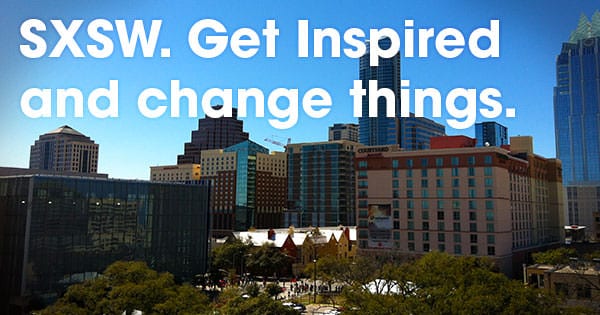
Unless you're one of the lucky few, work can become monotonous. Same commute. Same desk. Same issues.
For this reason I leapt at the opportunity to head out to Austin Texas for South by South-West (SXSW) Interactive. Four days of inspiring learning and informal networking followed and I'd recommend that if you ever get the chance to go, take it.
It's difficult to download everything that you experience at SXSW into a single presentation or post. Rather than give a travel log or diary entry on the events, I hope to offer some inspiration from my notes. I've picked 5 of the things that made me really sit up and pay attention and then after each item I've posted questions designed to inspire you on how to improve your job, business or life.
Ultimately I want my post to inspire you to build or improve something. Everyone drinks in so much content and information these days that it's easy to forget to stop and apply it. What have we changed? What have we shipped? What have we built?
1. Disruptive Innovations are Hardware Based
SXSW has a history of announcing the next big thing such as Twitter. This year the crowds were wowed by hardware rather than software. First there was the MakerBot Replicator, an affordable 3D scanner and printer combined. Interestingly the MakerBot was conceived and developed by Bre Pettis who wanted an affordable way to design and make things, a task that was always prohibitively expensive.
The second hardware innovation that made people literally gasp was the Leap Motion. I can't explain it well so I'll allow YouTube to demonstrate:
ARVE error: need id and provider
Nike's Fuel Band was the final innovation that captured conversations and many people were spotted with them. In the Fuel Band, Nike has created something that is social, good, fashionable and new. Along with FlyKnit trainers, the FuelBand helped Nike win the most innovative company of 2012 award.
- What service or product could your company turn into a piece of consumer hardware?
- What do your customers want to do that is expensive? How could hardware change that?
2. Gamification and Big Data
Despite the title of this panel session being full of two overused buzz words, I went along and was really impressed. The question that has stayed with me since the panel was "when should we not use gamification?" The panel couldn't answer the question and neither could anyone in the room. Gamification is used in everything from the military through to school and enterprises can benefit by applying it well.
- How could you reward customers for taking the action you want them to?
- What would make customers come back to you regularly?
3. Build Platforms for Others to Build Upon
Tim Berners-Lee, the creator of the world-wide web, spoke in the main convention centre to a packed out audience on the need for an open and private web. It was a fascinating lecture on the birth and development of something we use everyday. His challenge to everyone was to not accept the way things are. If something is broken, slow or unsatisfactory; build something better. Tim also challenge the audience to build platforms over solutions.
Platforms can be easily built upon by others and can be used in ways that you didn't think possible initially. In computing a platform is what developers build their solutions on. In automotive terms a platform may be a chassis upon which multiple cars can be built on.
In broader terms a platform may be marketing template or a format for holding meetings.
- What platforms could be used in your business?
- What knowledge do you have that could be translated into a platform for others to use?
4. Cloud first; Mobile first
Tim Berners-Lee and Werner Vogels (VP and CTO of Amazon) gave two separate but related pieces of advice. Tim counselled that we should think "mobile first". Werner advised that we should think "cloud first". I think both priorities can be brought together in to "think mobile and cloud first". The challenge to us is to essentially break down old ways of thinking and consider what could be achieved with mobile solutions that are tied to infinite storage and processing capabilities in the cloud.
- How is your business putting mobile and cloud first?
- What could you business provide if it could do anything imaginable through a mobile phone?
5. Affinity and Intent
I know that one of my friends is in Thailand right now and he's interested in action video games. I didn't need to stalk him to get this information he shared it freely with the world.
People are now sharing more than ever about the things they're passionate about and interested in. Marketers can therefore derive affinity from this data to improve marketing. Similarly marketers could derive intent by knowing what someone is searching for. If I've searched for BMW and then Autotrader, chances are that I'm in the market for a new German saloon. This information is useful for marketers to help them improve both the relevance and targeting of advertising online and offline.
Google and Facebook are the two major holders of this data at the moment and there is a battle being played out to open this data to advertisers. Nate Elliott of Forrester explained in much more detail than I can and you can find out more at his blog. Whilst it does open up interesting opportunities for marketers, it makes me a little more wary about what I share, like and search for...
- What do your customer's actions tell you about the affinities and intentions?
- How would knowing your customer's affinities and intentions change your marketing?
How have you been inspired?
It'd be good to hear any of your ideas that this article has inspired. Connect in the comments or via Twitter using @sealeyd.






